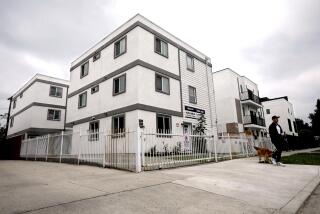A sweet place to bunk
With foreclosures on the rise and for-sale signs all over neighborhoods, owners across the country are struggling to find ways to meet their payments and stay in their homes. One possible solution is to open your doors to airline employees looking for what is known in the industry as a “crashpad.”
Despite a relatively low profile, crashpads are not a new idea and are nearly as old as the airlines themselves. Pilots, flight attendants and other airline employees may live in one city but fly out of another one, sometimes hundreds of miles away. Often this gap between home and base is the result of employees’ shifting schedules or changing to a different airline. Others find their base city to be too expensive to live in.
Although employees’ benefits allow for free or cheap commutes by air, schedules don’t always offer much flexibility -- 6 a.m. flights and sporadic on-call schedules can make lodging in surrounding airport neighborhoods a necessity.
When crew members live in one state but travel to another for work, the airlines are not required to pay for their accommodations. Flight crews are offered complimentary hotel rooms only when en route or on a layover.
In the Los Angeles area, crashpads can charge around $250 to $350 a month per bed, sometimes more if a private room is offered.
This system allows crews to keep their living costs down and gives homeowner-landlords more opportunity for income. Rooms are usually set up to sleep two, four or even six and are often fitted with bunk beds.
With Hawaiian, Skybus and ATA all calling it quits this year, airline personnel are feeling the strain of budget cuts and worries about job security. And although some may consider a hotel to be a more comfortable solution than bunking with strangers, a crashpad is a bargain, considering that the cost of a hotel room ranges from about $100 to $150 a night near LAX.
Crashpad layouts vary with the property and may be a spare room in someone’s home or an entire house devoted to airline renters. The least desirable kind of crashpad among crew members is one that offers only a bed for the night.
Instead, many crew members look for crashpads that have kitchen privileges, Wi-Fi, nearby restaurants or a grocery store, laundry and, of course, close proximity or convenient transportation to the airport. Sleeping arrangements are usually same sex and same profession: Pilots tend to bunk with other pilots and flight attendants with other flight attendants.
Robert Zajc faced his own crashpad dilemma. While he was living in the Corona area and working for Northwest Airlines as a flight attendant, the company moved his base several times and recently required him to fly out of Boston. After briefly considering selling his four-bedroom, 3,024-square-foot home, he decided against it.
To offset his living expenses, he’s in the process of renting out four bunk beds in an extra bedroom in his own home at $250 per person, per month. The fee includes use of one bathroom, a pool and basic storage for linens.
Zajc said he prefers this arrangement to taking in a boarder as crews need a crashpad for only a few nights a month, unlike traditional long-term renters.
And the airline industry’s rigorous background and security checks for all of its crews give him some peace of mind about who will be staying at his place, he said.
Homeowners with empty rooms to spare also can look to crashpads as a temporary solution to help meet resetting mortgages or as a way to stay ahead of the curve and offset their expenses.
Curious about how to find a tenant?
Convenient and quality crashpads aren’t necessarily easy to come by. The best are usually full or booked months in advance, and what’s left are usually less desirable setups or require a long and costly taxi or shuttle ride from the airport.
To find crew members actively looking for rentals, landlords can post their crashpads at websites including www.airlinecommuter.com, www.crashpads.com, www.craigslist.org and www.airlinecrew.net. Set your prices based on what other crashpads in your area are going for, while considering the number of beds per room and any extra amenities.
Before delving into the world of crashpads, consider the reality of strangers sharing your bathroom, using your kitchen and watching your TV when you’re trying to unwind after a long day at work.
If you have the space for a separate airline “lounge” right in your home with television, computer and private bathroom, you’ll give yourself some privacy.
Leases are rarely used with crashpads, which largely rely on verbal agreements.
From a legal perspective, crashpad renters are akin to boarders or lodgers who rent a room in someone’s home and aren’t required to have a formal agreement or lease.
If you choose to forgo a written agreement with your renters, take the added precaution of setting ground rules in advance.
And legal experts recommend you check with your lender first -- the terms of your mortgage may require you to seek permission before renting out a spare room.
Although the rental income of a crashpad must be reported on your taxes, consider the incentives of rental deductions. According to the Internal Revenue Service, updates, repairs and upkeep for a room rented in your own home can be deducted.
But keep in mind that it’s always wise to speak with an accountant to address any potential deductions and income issues that may arise.
More to Read
Sign up for The Wild
We’ll help you find the best places to hike, bike and run, as well as the perfect silent spots for meditation and yoga.
You may occasionally receive promotional content from the Los Angeles Times.






